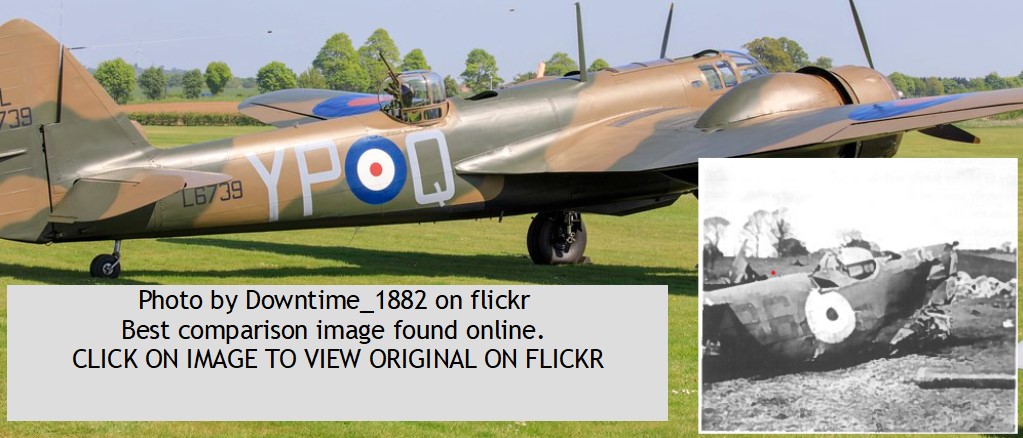Bristol Blenheim, Killeen, Co. Mayo, March 1942
On Friday the 13th March 1942, four young men of the Royal Air
Force suffered a painful end to a routine training flight when
they were forced to land among the small stone walls of County
Mayo.
An aircraft had been observed heading east from Corraun Point,
Co. Mayo at 15.45hrs and later, circling over Laherdaun.
The landing at Killeen was said by witnesses to have been at
16:15hrs. The Army recorded afterwards that an aircraft
had been fired upon by the Army post at Rathmullen, on Lough
Swilly in Donegal, at 13:00 hrs, the suggestion being that it
was this aircraft.
The Irish Army after the crash recorded that Michael O'Malley
and his two daughters, Claire and Mary were first on the scene
and helped to remove the injured crew members from the wrecked
aircraft. They then provided first aid to their
injuries. Neighbours James Gallagher and Mrs Healy
provided refreshments for them after they were taken into Mrs
Healy's home until the authorities arrived. Local doctor H
J Harte was noted as having provided medical assistance.
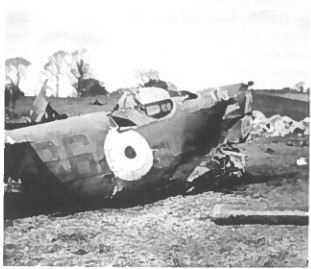 The Army also recorded the assistance provided by
Michael Mulvihill, Killeen and Tom Maycock from Rathkell,
Laherdaun in carrying the injured on stretchers. The
wrecked aircraft was noted as having the markings Z6021 and
large letter B6 on the fuselage and it was noted that it was a
'long nosed' Blenheim. This reflected the fact it was a
Bristol Blenheim Mark IV. So far during the war, two
intact short nose Blenheim Mark I had been involved in landings
at Belcotton, Co.
Louth and on the sea front at Clontarf, Co. Dublin.
This would be the first somewhat intact Blenheim Mark IV.
That said, as can be seen from the photo of the wreckage, it was
very badly damaged. The army reports describe it as having
had its engines torn off and the fuselage broken in several
places. it had appeared to overshoot one field, went
through a hedge, then through some boulders and ending up in a
stone wall.
The Army also recorded the assistance provided by
Michael Mulvihill, Killeen and Tom Maycock from Rathkell,
Laherdaun in carrying the injured on stretchers. The
wrecked aircraft was noted as having the markings Z6021 and
large letter B6 on the fuselage and it was noted that it was a
'long nosed' Blenheim. This reflected the fact it was a
Bristol Blenheim Mark IV. So far during the war, two
intact short nose Blenheim Mark I had been involved in landings
at Belcotton, Co.
Louth and on the sea front at Clontarf, Co. Dublin.
This would be the first somewhat intact Blenheim Mark IV.
That said, as can be seen from the photo of the wreckage, it was
very badly damaged. The army reports describe it as having
had its engines torn off and the fuselage broken in several
places. it had appeared to overshoot one field, went
through a hedge, then through some boulders and ending up in a
stone wall.
A comparison to a complete aircraft can be made using this amazing image taken in 2018 by Flickr user Downtime_1882, showing how much damage there appears to be to the Blenheim. it appears to be completely severed along the line of the rear edge of the wing.
The pilot reported to the Irish Army that he was on a training
mission from the Isle of Man, that his wireless set went out of
service, they lost their bearings and thus ran low on
fuel. It was described as being grey and brown in colour
and was unarmed. The aircraft was flying from RAF Jurby
and belonged to No 5 Air Observers School. This, as the
name suggests was a location where observers, the term the RAF
used for navigators, were trained. This flight was
undertaken to allow the two pupils, Haynes and Dunlop to gain
experience in navigation, with Sgt Thomas along to provide
wireless telegraphy assistance to them.
The AIR81/XXXX file for this crash contains a Air Ministry Form
765 with a large amount of data about the flight and the
findings of the investigation.
Thia aircraft took off on a Navigation
exercise over the Irish Seas at 10.45 hours on 13th March
1942. The pilot departed from Base without obtaining
W/T GO contrary to regulations and specific instructions by
his Flight Commander. The route to be followed was:—
Jurby — Morecombe Bay L.V. — 53o 28'N 5o
55' W - Bardsey Is. - Rockabill - Jurby. The
weather experienced was not good - Visibility 2-4 miles;
cloud 10/10 or 1,000' to 2,000'. Only one aircraft
completed the exercise, the remainder returning to base soon
after take-off. It would appear that the crew of the
aircraft in question became loast and force landed in Eire
when out of petrol at approximately 16.00 hours.
The commander of the Training Wing added to the report in
relation to contributory factors: No
communications was established with the aircraft from the
time of take-off till the landing. it is possible that
the pilot took over the navigation after E.T.A. base and got
hopelessly lost. it is unlikely that the crew were
able to get any D/F assistance. Pilots have order to
return to base if W/T 'GO' is not received with 5 minutes of
take-off.
This would appear to be a case of disobedience of
orders.
The report
concludes with the officer Commanding 5 AOS stating that
disciplinary action would be taken against young Rawcliffe
upon his return to the unit. This was signed off on
the 17th March 1942 with no obvious input from the pilot or
other crew members.
It is worth noting
that there is a lot of confusion relating to the serial
number of the aircraft involved. A primary source in
this case is the Irish Army report which states that the
serial read from the rear of the aircraft was Z6021.
The pilots log book, in a not uncommon fashion refer to the
aircraft only by its numbers, 6021 while one of the trainee
navigators recorded his mount as V6021. As luck would
have it, there were two Blenheim Mark IV aircraft with both
serials, V6021 and Z6021. The RAF and Air Ministry's
records refer to the aircraft a V6021 on telegrams sent on
the day of the crash but also on the Form 765 written up
four days later. This in itself might not be a problem
other than four month later in Egypt, three young men died
when another Blenheim crash on take off. Three of the
men were members of the Royal Australian Air Force members
and all their casualty files refer to that aircraft as being
V6021. The Form 78 aircraft record cards for the two
aircraft record Z6021 being with 5 AOS since December 1941
and crashing in Ireland while V6021 was with 5 AOS early in
1942 but was transferred to North Africa. Perhaps a
error by a clerk in 5 AOS was transcribed throughout the
history of the event.
A visit to Kileen
in 2024, revealed that the crash took place in the fields
behind the Lough Conn Milling Company Buildings, which was
operated at that time by Michael O'Malley and his
family. The crashed aircraft ended up it seems in the
far corner of the field shown in the photo below.
The following story comes from a local history publication,
The Deel Basin, published in 1990 by the Crossmolina Historical
and Archaeological Society. I have included it for its
local interest and the details of the crew and the O'Malley's
family contact with one of the men's relatives.
It should be noted that the story refers to there being only
three men on board whereas there was of course four men, a crew
made up of one officer and three other ranks. The Wing
Commander Begg mentioned in the article below was not the men's
commander during the war, but was as noted by Sir H Maffey, the
United Kingdom Air Attache in Dublin. This telling of the
story seems to form the basis for the entry in Donal McCarrons
book, Landfall Ireland.
DURING the afternoon of Friday, 13th
March, 1942, the peace and quiet of Crossmolina was
disturbed by the sound of a low-flying aircraft. It was not
too unusual to hear a plane as this was during the war years
and English planes had occasionally flown over this part of
the country. The pilot of this particular RAF aircraft had
flown off course. He was not familiar with the area, nor
were his two colleagues. They were looking for a place to
land as fuel was running dangerously low. They flew over
Crossmolina a number of times to see if there were any flat
fields where they could land their aircraft. They even
considered landing on some straight road but all the flat
fields around the roads were all spiked with wooden stakes.
For those of us who are too young to remember, the purpose
of spiking roads and fields with wooden stakes was to
prevent enemy planes from trying to land on our native soil.
This was a task undertaken by the Local Security Force
(L.S.F.). Unfortunately for this pilot and his crew the LSF
in the Crossmolina area had done a very good job. Having no
luck in Crossmolina the pilot decided to head out into the
countryside in a desperate attempt to find a place to land
his aircraft. At this stage they were running on a
practically empty fuel tank.
Michael O'Malley was sitting at home by the fire with
his two daughters, Claire and Mary, when they heard the
distant sound of an approaching aircraft. As the plane got
nearer Michael realised by the sound of the engine that
there was something wrong. The three of them rushed out into
the yard. Michael O'Malley was a member of the local
security force and he knew that his experience was going to
be called upon at this moment. He knew that the pilot was
going to have to land very quickly so as to avoid crashing
which would possibly mean the loss of all of those on board.
Michael grabbed a white cloth that was hanging on the
clothes line and ran over to a stone wall that was bordering
a field near the house. He realised that this was the only
field where the pilot would have any chance of landing his
plane successfully. The pilot had spotted the three people
running out of the house. He saw one of them with a white
flag and had no choice but to trust this man on the ground.
Michael stood on top of the stone wall waving his flag
in the direction of the field behind him. The pilot was now
really struggling to keep the plane airborne. He saw the
field that he was being directed to and prepared to land.
Unfortunately he misjudged the height of the stone wall and
got his undercarriage caught in it.
There was a loud bang as the plane hit the ground.
Michael O'Malley and his two daughters ran up to the plane
to help the crew. Two* of the officers were injured and the
other* was suffering from shock. The three* men were taken
from the plane as quickly as possible. Claire O'Malley was a
member of the Red Cross and now more than ever her skill and
expertise were needed. The two* injured officers lost a lot
of blood. Claire administered first aid and made the men as
comfortable as possible. It was not very long before help
arrived in the form of the Irish army who took control of
the situation. The three* men were brought immediately to
Castlebar Hospital for medical attention. An armed guard was
appointed to guard the plane and its wreckage until it was
removed. The day after the accident the O'Malley family
travelled to Castlebar to see the officers, but the three*
men were under armed guard at the hospital and nobody was
allowed to visit them. The good wishes of the three* men and
their gratitude was expressed to the O'Malley family by an
RAF senior officer.
A few years later, after the war, the O'Malley's were
visited by Wing Commander Begg, who was the senior officer
of the RAF pilot and his crew**. He expressed his thanks for
the bravery and kindness shown to the officers. Two weeks
after the plane crash at Killeen the U.K. representative of
the RAF based in Dublin
wrote a letter to Michael O'Malley and his family to
express his gratitude.
United Kingdom Representative To Eire,
50 Upper Mount Street,
Dublin.
27th March, 1942.
Dear Mr. O'Malley,
I am writing to express to you my thanks for the assistance
you gave to the injured RAF officer and airmen after their
plane had crashed near Crossmolina, Co. Mayo, on March 13th.
I understand you personally removed the injured men from
their machine and that your daughters, Claire and Mary,
rendered first aid. The prompt action of yourself and your
daughters is much appreciated by me and by the members of my
staff.
My Air Attaché, Wing Commander Begg, visited the hospital at
Castlebar on March 14th and would have called on you
personally to convey our thanks, but unfortunately this was
not practicable.
With many thanks,
Claire O'Malley wrote to the family of
the pilot whose name was Henry Thomas from South Wales. The
pilot's girlfriend wrote a nice letter in reply, which
follows:
63 Count Road,
Barry, Glann,
S. Wales.
6th April.
My Dear Miss O'Malley,
Your letters came as a
great relief both to Mr. and Mrs. Thomas and to me, and I
should like to thank you and your father for the great
kindness you
showed to Henry and to his companions. They were certainly
very fortunate in having you at hand to help them and I have
since heard from Henry just how
good you were.
You will be pleased to
know that last week Henry was home and you can imagine how
pleased we all were to see him looking quite well and very
pleased with himself.
He is back at his old station now, so if you have been
wondering what to do with the letter I sent, you could
repost it to:
Sgt. H. S. Thomas
983327,
Sergeant's Mess,
R.A.F., Jurley.
I.O.M
We shall never forget
your kindness and, as Henry suggested when he was at home,
maybe when the war is over we shall be able to visit Eire
and then
we shall be able to thank you and your
father personally.
Yours sincerely,
Marjorie Pemberton
The four crew members suffered a variety of injuries as
recorded in both the Irish Army report, G2/X/0985 and the UK Air
Ministry port AIR81/XXXX.
Wing Commander M G Begg and his wife arrived in Castlebar on
the 13th March and the following day brought away P/O Rawcliffe
and Sgt Thomas, bringing them to the Beleek border post with
Northern Ireland at 14:35 hours. The two remaining men,
Haynes and Dunlop, were brought to the border on March 19th.
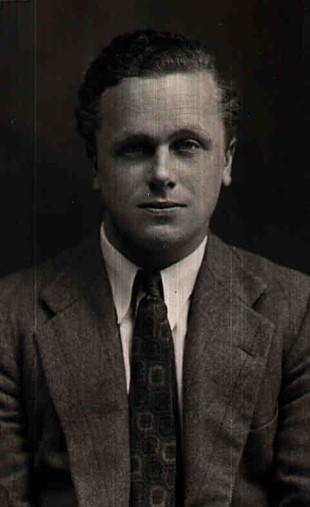 P/O
Donovan Hilton RAWCLIFFE 106079
P/O
Donovan Hilton RAWCLIFFE 106079
Donovan was born in June 1918 to Dorice and Donovan McClean
Rawcliffe in Canterbury, Kent. They married in 1917 when
Donovan senior was a Sergeant in the Royal Flying Corps.
His father had been a prewar officer in the Manchester
Regiment. His father
Donovan arrived in New York in July 1939 as a 21 year old
Cambridge student going on a Thomas Cook holiday. He
travelled on to Bermuda and back to New York via Rio de Janeiro,
Brazil. He at that time held a Royal Aero Club pilots
certificate having learned to flying with the University Aero
Club, Cambridge.
He suffered a broken arm and cuts to his forehead during the
landing in Killeen. He was taken across the border along
with Sgt Thomas on the day after the crash by M G Begg, the UK
Air Attache.
By chance, Donovan Rawcliffe's log book survived the war and was bought by a militaria collector who kindly provided a copy of the page for the day of the crash. Besides this, he was able to advise on his wartime flying career which was actually rather short. He began his training at XXX in May of 1941. He was awarded his flying badge with effect from 3rd September 1941. He was posted to Jurby in at least February 1942 and that portion of his RAF ended with the crash in Mayo. It is noted that he only recorded Dunlop and Haynes as his crew on the log page, this may have reflected their being pupils while Sgt Thomas was present as the wireless operator, however the distinction would be strange. RAF and Irish records otherwise confirm the four men were on the aircraft.

He did not return to flying until March 1944 when he arrives at
28 Elementary Flying Training School at Wolverhampton. He
flies a number of times on what appear to to be refresher
training flights both with an instructor and solo, but the last
flight is on the 5th of May 1944, and the log ends there.
The London Gazette provides a glimpse of his wartime progress
having been commissioned as of 7th October 1941, and his
promotions as Flight Officer and Flight Lieutenant published a
year after. An August 1944 Gazette however lists his
transfer from the General Duties branch to the Administrative
and Special Duties branch, indicating again that his wartime
flying duties were at an end. This was followed by a
notice in September 1944 that, due to ill health, he was
relinquishing his rank.
His name appears a year later as a 2nd Lieutenant in the Territorial Army Reserve of Officers before again relinquishing the rank in 1946.
1951 newspapers published a long article describing Donovan as
"... Mr. Rawcliffe, who is of independant means, ..." was
seeking a copy of a photo of naked Tibetan monks standing in
snow that he had seen on the cover of an unknown book he spied
in 1934/35 in a Harrow bookshop. He was seeking the photo
for his soon to be published book, The psychology of Modern
Occult".
Post war he can be found to have lived on the Isle of Wight
with addresses as various farms in the area. His name
appears in a number of newspapers leters pages putting forward
arguments in various debates and subjects.
He was the author of
He passed away in 1974
Sgt Henry Samuel THOMAS 983327
Son of William John and Jane Thomas, of Barry, Glamorgan where
they were found listed in the 1939 England and Wales register
living at the address he would give the Irish army three years
later.
Sgt Thomas was not recorded as having any injuries by the Irish
army and along with P/O Rawcliffe, was sent to the border with
Northern Ireland the day after the accident. He was
performing the role of wireless operator on the aircraft for the
training exercise.
Henry married Marjorie in the winter after his crash in
Ireland, sadly, she would loose him to the war in little under
two years. He went on to serve with 622 Squadron of Bomber
Command and on the night of 31 May 1944, he was shot down over
France in Lancaster ND926 by a German night fighter. He
was buried with his fallen crew mates in Marissel French
National Cemetery in the east of Beuavais. one member of
his crew managed to bale out, evade and survive the shoot
down. Part of his report upon return to the UK records the
terrible circumstances of Sgt Thomas's death:
I sighted a Ju 88 about 30 miles North
of Beauvais... He attacked us five times. The mid
upper gunner never opened fire and must have been
hit in the first attack.. After the first attack the
engineer reported on the intercom that our starboard
inner was on fire. Sheets of flames went by the rear
turret and I saw the Ju 88 coming again in our
direction. The captain ordered us to bale
out... I entered the fuselage.. the aircraft was
blazing furiously inside..... I put on my parachute
and baled out by the entrance door. The
aircraft went down in a screaming dive on fire from
nose to stern.. The next I knew I was in the air,
saw my parachute and knew I was alive. It
was a clear moonlight night and I could see the aircraft
blazing on the ground about ten miles north. I
looked around for other parachutes but could not see
any......
"I was told afterwards by a Frenchman who
records the graves of English airman and was present
at the funeral that my crew were buried together
nearby and were recorded as five bodies. The
aircraft blew up from its own bomb upon crashing and small
pieces were picked up 2 miles away, it was
impossible to know how may bodies there were — and I
feel that all the remaining six Of the crew, not
five, were blown to pieces and buried. From a
description of part of one of them I am almost
certain the Pilot was amongst those buried"
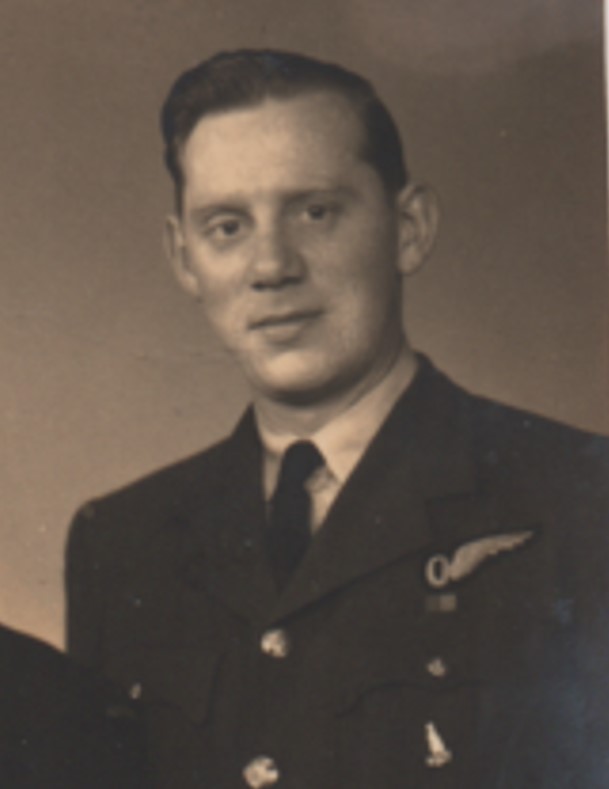 Cpl Robert
HAYNES 1004181
Cpl Robert
HAYNES 1004181
Born on the 19 February, 1916 he was the son of Robert and Lily
Haynes, nee Langley. He was working as a plaster block
process worker in 1939 register and the family lived at Hawke
Street, Haverton Hill, Billigham, Durham.
His son very kindly provided a copy of his log book and in this
he records the purpose of the mission and the route taken.
He listed himself as 2nd Navigator, but passenger is also
written in the duty column.
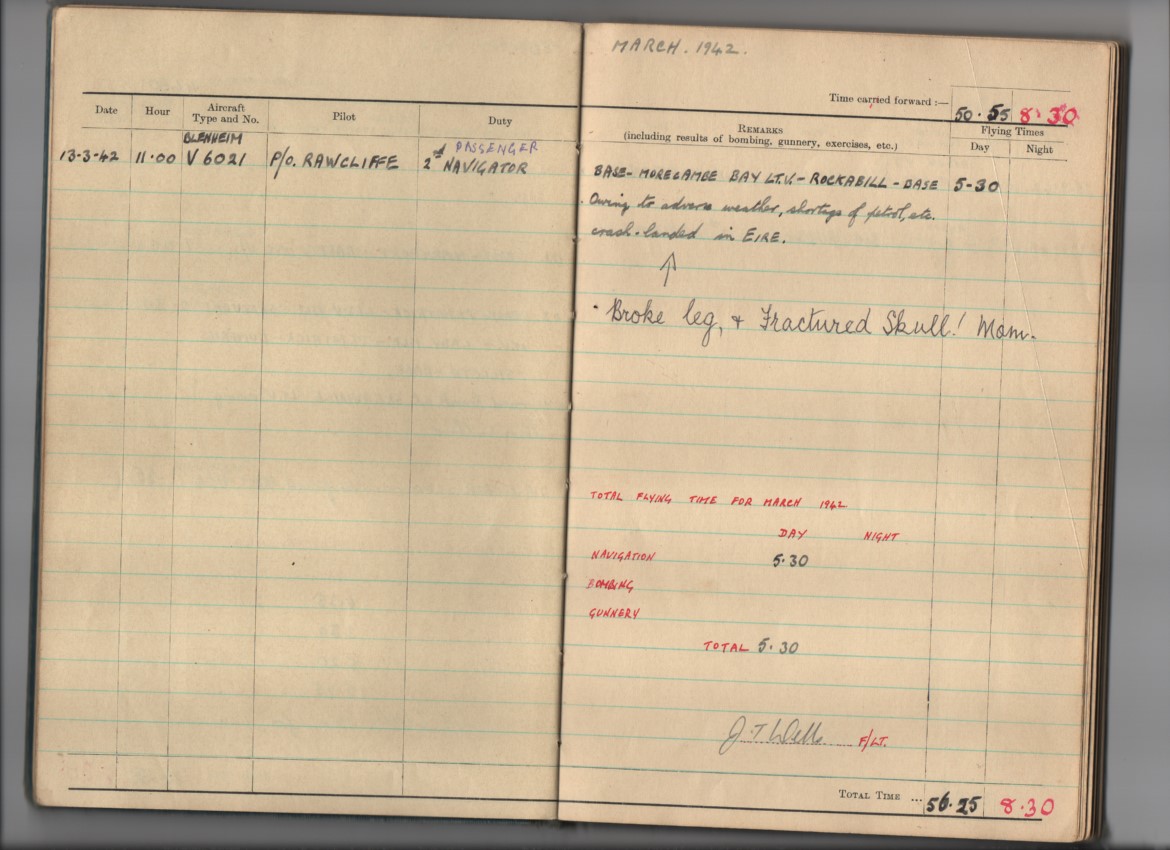
Robert returned to flying duties in September 1942.
Following more training he was posted from 13 Operational
Training Unit to 88 Squadron in June 1943. He flew there
for twelve month with his captain Edward G Connor RAAF using the
twin engine bombers for strikes on targets in occupied
Europe. Many years later, in 1978, Robert was able to
visit Australia and met his former pilot in Sydney.
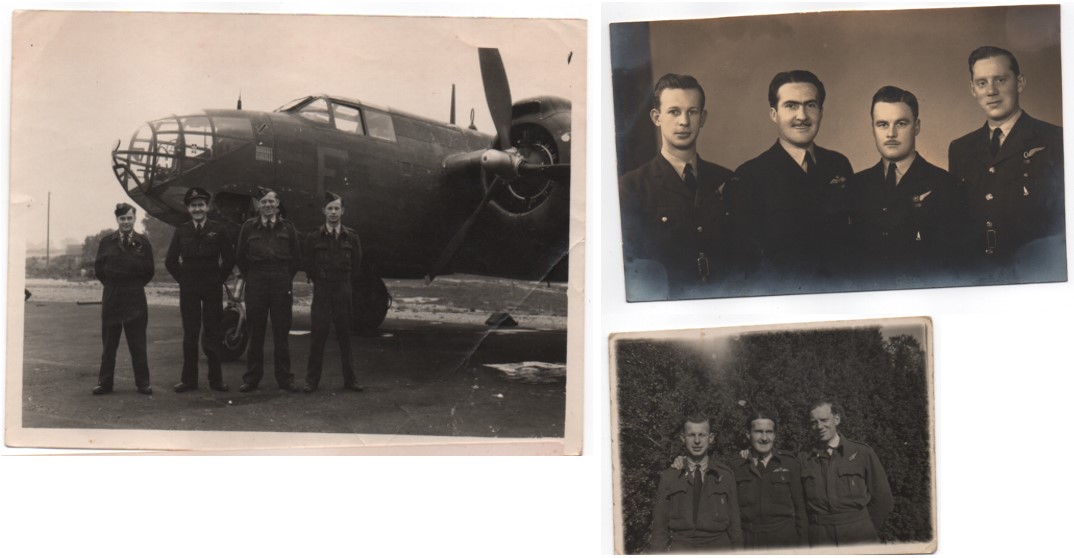
In 1945, Robert undertook a course in the RAF School of
Administration and Accountancy.
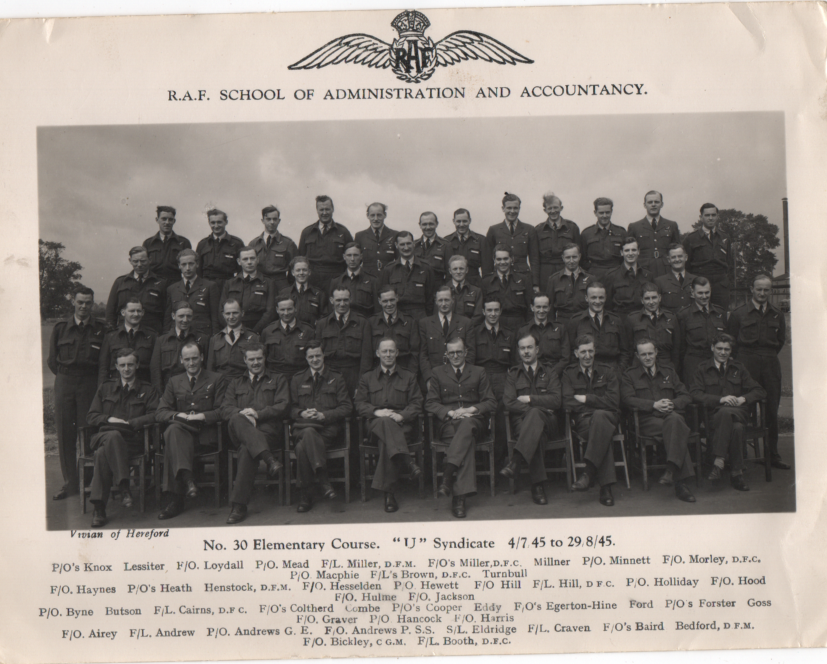
Robert is the fifth man from the left at the rear of this
group.
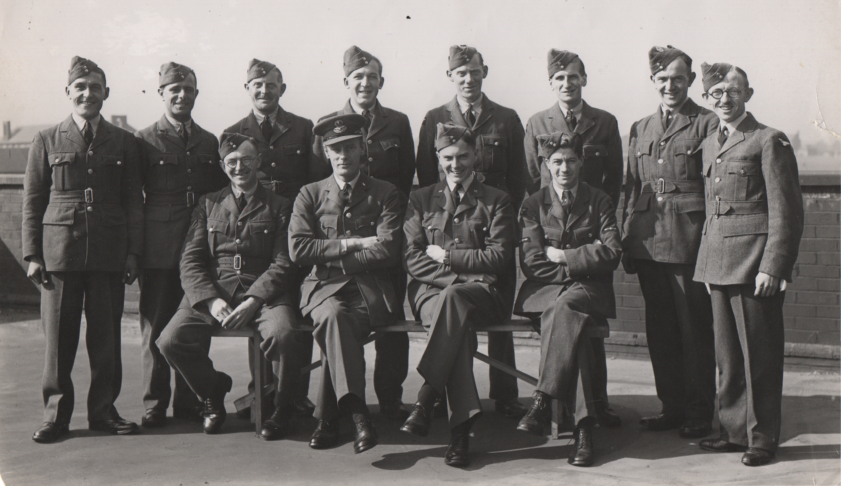
His brother, Norman Haynes was lost on 18 April 1945 when his 8
(Coastal) OTU Mosquito was forced to ditch in the sea off Ramsey
Head, Pembrokeshire.
Robert passed away in December 1996 in Stockton, Durham in
England.
LAC Joseph DUNLOP 1374048 was the son of Jean and George
Dunlop from Glasgow, living at the time of the crash at 299
Edgefauld Road in the city. Joseph was born on the 8 of
August 1918
He suffered injuries in the crash including a broken ankle,
bruising to his face and most seriously, the loss of two
fingers. From the AIR81 file it is apparent that his
father made much efforts to learn about his sons condition in
the days immediatly after the crash, even sending telegrams to
Sir John Maffey in Dublin and phoning the RAF Attache's office.
it is not confirmed but he may have passed away in 2000 in
XXXX.
The tattered remains of Blenheim Z6021 were dealt with by Army
personnel in the days that followed. Some recovered
equipment was brought to Baldonnel followed by the remaining
scrap on the 19th of March.
Compiled by Dennis Burke, 2024.

